Exploring Traditional Wedding Attire: Zulu, Tsonga, and Xhosa Styles of South Africa
The Zulu people, renowned for their rich cultural heritage and vibrant traditions, celebrate weddings with unique customs and attire. The Zulu traditional wedding dress is a significant aspect of these celebrations, reflecting the cultural identity and regal flair of the community. Here’s an overview of the Zulu traditional wedding dress:
- Isicholo (Headpiece):
- The isicholo is a distinctive Zulu bridal headpiece, often referred to as a hat or crown. It is a broad, circular-shaped hat adorned with beads and can be quite large. The isicholo is a symbol of respect and is worn with pride by Zulu brides.
- Izigege and Inkehli (Apron and Skirt):
- The izigege and inkehli are essential components of the Zulu bride’s attire. The izigege is a beaded apron worn around the waist, while the inkehli is a fabric skirt. Both pieces are adorned with intricate beadwork and patterns.
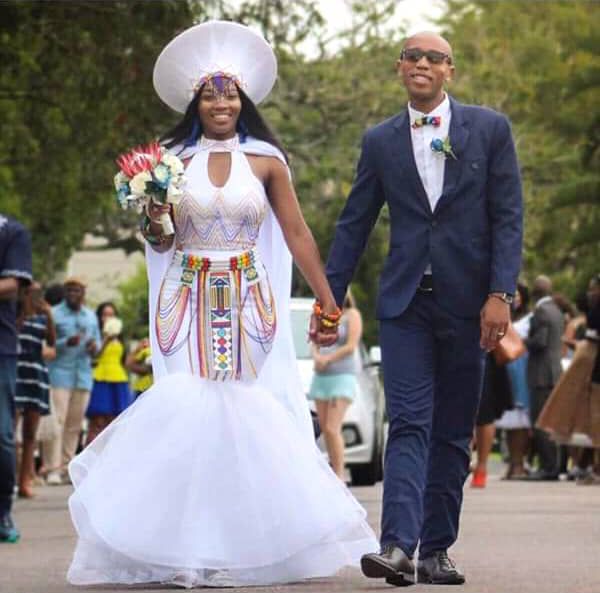
- Umbhaco (Traditional Attire):
- The umbhaco is a traditional Zulu outfit worn by brides. It typically includes a beaded bodice, a skirt, and a shawl. The beadwork on the bodice is meticulously crafted, forming patterns that may have cultural significance.
- Izihawu (Beaded Jewelry):
- Zulu brides wear an array of beaded jewelry known as izihawu. This includes necklaces, bracelets, and anklets, all intricately beaded with colorful patterns. The jewelry serves as a symbol of beauty and cultural identity.
- Izinculuba (Beaded Neck Ring):
- The izinculuba is a beaded neck ring worn by Zulu brides. It is a symbol of marital status and is worn with pride during the wedding ceremony. The beadwork on the izinculuba is often vibrant and eye-catching.
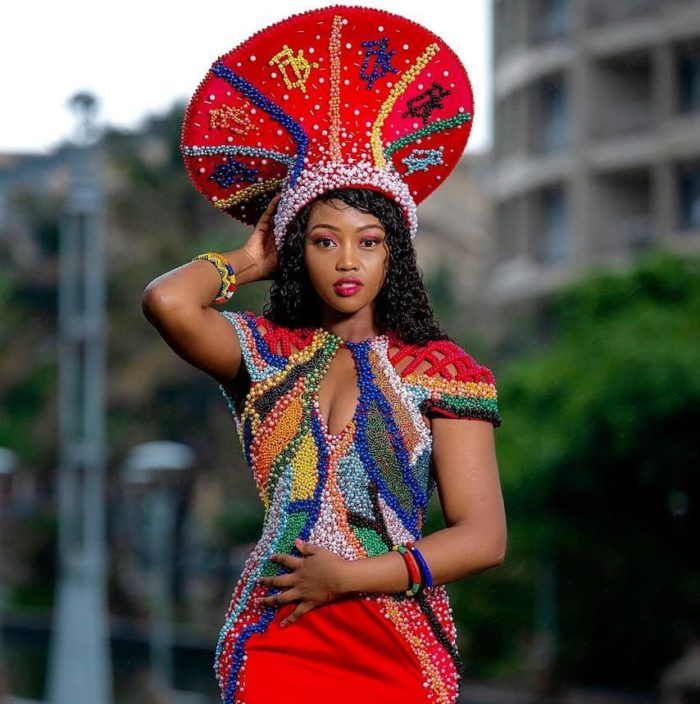
- Umqhele (Headband):
- The umqhele is a beaded headband worn by Zulu brides. It complements the isicholo and adds a touch of elegance to the overall look. The umqhele is often adorned with beads and may have symbolic elements.
- Iziboroko (Beaded Anklets):
- Zulu brides may wear beaded anklets known as iziboroko. These anklets are crafted with colorful beads and add a finishing touch to the bride’s ensemble.
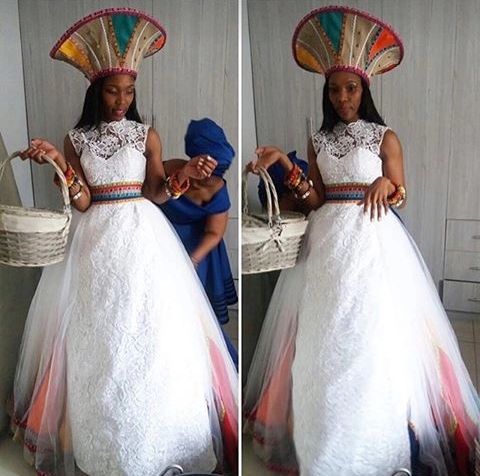
- Contemporary Influences:
- While traditional elements are highly valued, some Zulu brides may incorporate contemporary influences into their wedding attire. Modern designs may blend traditional beadwork with contemporary silhouettes.
The Zulu traditional wedding dress is a captivating blend of vibrant colors, intricate beadwork, and cultural symbolism. It serves as a visual representation of cultural pride, family traditions, and the celebration of love within the Zulu community. Each element of the attire carries cultural significance, making the Zulu traditional wedding dress a cherished and meaningful expression of their heritage.
The Tsonga people of South Africa Traditional Wedding Attire
The Tsonga people, with their rich cultural heritage, celebrate weddings with unique customs and attire. The Tsonga traditional wedding dress is a significant aspect of these celebrations, reflecting the cultural identity and artistic expression of the community. Here’s an overview of the Tsonga traditional wedding dress:
- Xibelani (Traditional Skirt):
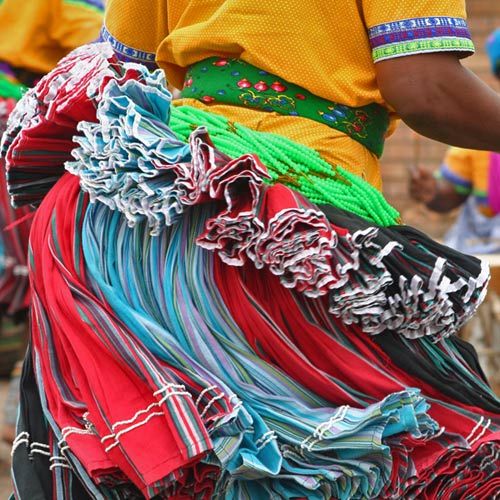
- The xibelani is a distinctive Tsonga traditional skirt worn by brides. It is characterized by multiple layers of colorful fabric that create a voluminous and dynamic look. The xibelani is often adorned with bright patterns and can be twirled during traditional dances.
- Top/Shirt and Shawl:
- The bride typically wears a matching top or shirt that complements the xibelani. The ensemble may also include a shawl draped over the shoulders, adding elegance to the overall look. The top and shawl are often adorned with intricate beadwork and embroidery.
- Beaded Accessories:
- Beadwork is a prominent feature in Tsonga traditional wedding attire. Brides adorn themselves with beaded accessories, including necklaces, bracelets, and anklets. The beadwork often features vibrant colors and traditional patterns.

- Mukhwevo (Headpiece):
- The mukhwevo is a beaded headpiece worn by Tsonga brides. It is crafted with colorful beads and may include symbolic elements. The mukhwevo is worn with pride and adds a regal touch to the bride’s overall appearance.
- Miceke (Beaded Belt):
- The miceke is a beaded belt worn around the waist. It is intricately crafted with beads and may feature geometric patterns. The miceke serves both a functional and decorative purpose, enhancing the bride’s attire.
- Ijogolo (Beaded Leg Bracelets):
- Tsonga brides may wear beaded leg bracelets known as ijogolo. These bracelets adorn the ankles and add a distinctive touch to the bride’s ensemble. The beadwork on the ijogolo may carry cultural significance.

- Miceke (Beaded Armbands):
- Beaded armbands, also known as miceke, are worn by Tsonga brides on their upper arms. These beaded accessories contribute to the overall beauty and cultural richness of the bride’s attire.
- Contemporary Influences:
- While traditional elements are highly valued, some Tsonga brides may incorporate contemporary influences into their wedding attire. Modern designs may blend traditional beadwork with contemporary silhouettes.
The Tsonga traditional wedding dress is a beautiful representation of cultural pride, artistic expression, and the celebration of love within the Tsonga community. Each element of the attire carries cultural significance, making the Tsonga traditional wedding dress a cherished and meaningful expression of their heritage
A Deep Dive into The Xhosa people Traditional Wedding Dress
The Xhosa people, with their vibrant culture and unique traditions, celebrate weddings with distinctive customs and attire. The Xhosa traditional wedding dress is a significant aspect of these celebrations, reflecting the cultural identity and heritage of the community. Here’s an overview of the Xhosa traditional wedding dress:
- Umgwalo (Attire for the Bride):
- The traditional Xhosa wedding dress for the bride is known as “umgwalo.” It is a beautifully crafted ensemble that consists of various elements, each with cultural significance.
- Ivory Bracelets and Necklaces:
- The bride often wears ivory bracelets and necklaces, which are symbolic of purity and the transition into married life. These accessories are carefully chosen to complement the overall attire.
- Isicholo (Bridal Crown):
- The isicholo is a distinctively beaded bridal crown worn by Xhosa brides. It is a symbol of respect and dignity. The crown is adorned with intricate beadwork and may vary in size and design.

- Inxili (Traditional Skirt):
- The inxili is a traditional skirt made from fabric or animal skin. It is worn around the waist and is an essential part of the Xhosa bride’s attire. The design and color of the inxili carry cultural significance.
- Ukugquma (Beaded Bodice):
- The ukugquma is a beaded bodice worn by the bride. It is crafted with meticulous beadwork, forming patterns and symbols that hold cultural meaning. The beadwork is often vibrant and adds a pop of color to the overall ensemble.
- Ivory Beadwork:
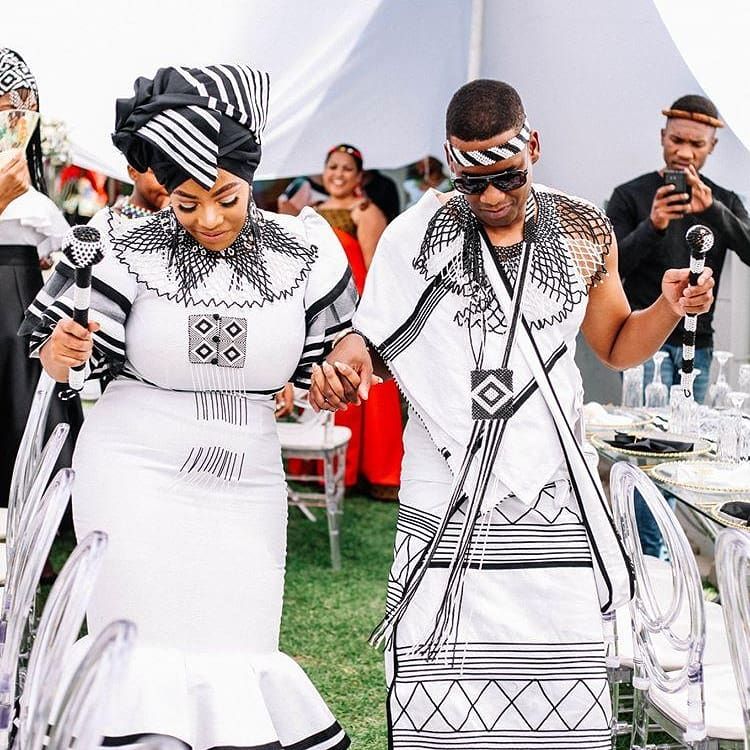
- Ivory beadwork is commonly featured in Xhosa traditional wedding dresses. Beads are carefully arranged to create intricate patterns, and the use of ivory symbolizes purity and the importance of family ties.
- Umbhaco (Traditional Shawl):
- The umbhaco is a traditional shawl worn by Xhosa brides. It is typically draped over the shoulders and serves both a functional and aesthetic purpose. The shawl is adorned with beadwork and adds elegance to the bride’s look.
- Umbhinqo (Beaded Belt):
- The umbhinqo is a beaded belt worn around the waist. It is intricately beaded and complements the overall ensemble. The beadwork on the belt may feature geometric patterns and symbols.

- Contemporary Influences:
- While traditional elements are highly cherished, some Xhosa brides may incorporate contemporary influences into their wedding attire. Modern designs may blend traditional beadwork with contemporary silhouettes.
The Xhosa traditional wedding dress is not only a garment but also a reflection of cultural pride, family traditions, and the celebration of love within the Xhosa community. Each element of the attire carries cultural significance, making the Xhosa traditional wedding dress a cherished and meaningful representation of their heritage.

